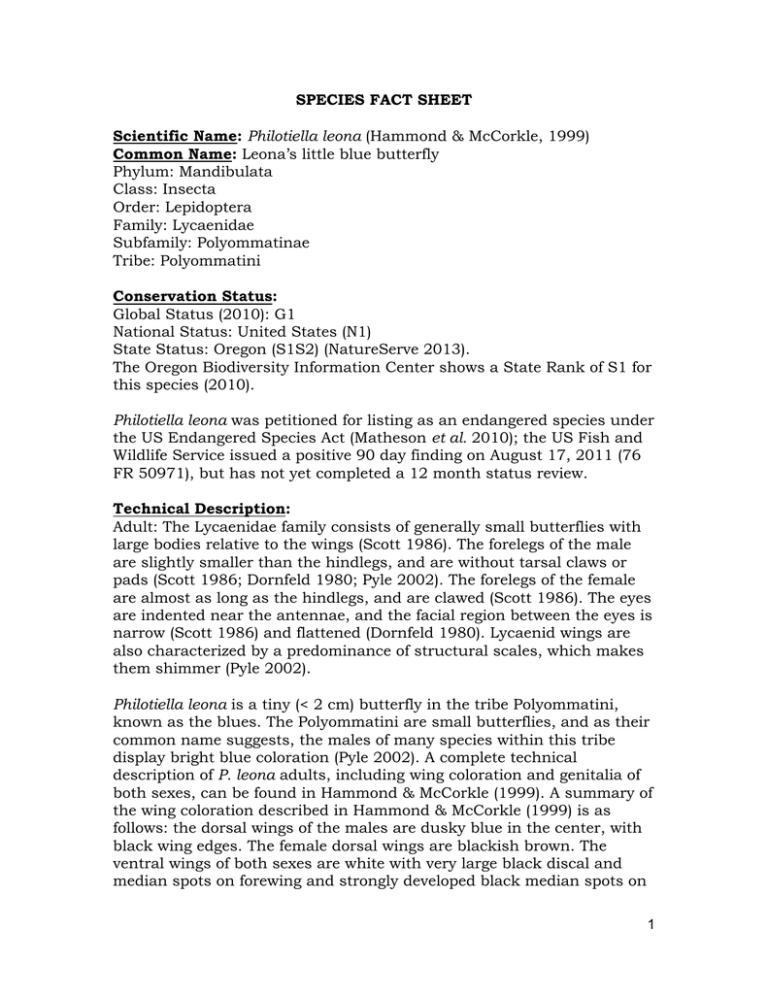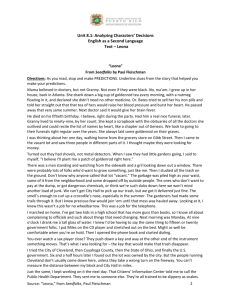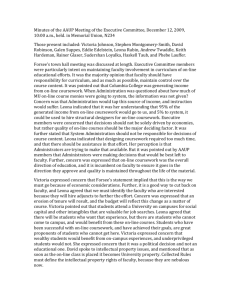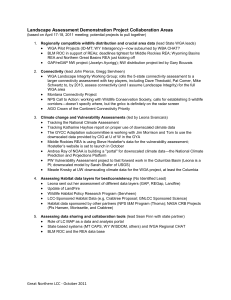SPECIES FACT SHEET Scientific Name: Common Name:
advertisement

SPECIES FACT SHEET Scientific Name: Philotiella leona (Hammond & McCorkle, 1999) Common Name: Leona’s little blue butterfly Phylum: Mandibulata Class: Insecta Order: Lepidoptera Family: Lycaenidae Subfamily: Polyommatinae Tribe: Polyommatini Conservation Status: Global Status (2010): G1 National Status: United States (N1) State Status: Oregon (S1S2) (NatureServe 2013). The Oregon Biodiversity Information Center shows a State Rank of S1 for this species (2010). Philotiella leona was petitioned for listing as an endangered species under the US Endangered Species Act (Matheson et al. 2010); the US Fish and Wildlife Service issued a positive 90 day finding on August 17, 2011 (76 FR 50971), but has not yet completed a 12 month status review. Technical Description: Adult: The Lycaenidae family consists of generally small butterflies with large bodies relative to the wings (Scott 1986). The forelegs of the male are slightly smaller than the hindlegs, and are without tarsal claws or pads (Scott 1986; Dornfeld 1980; Pyle 2002). The forelegs of the female are almost as long as the hindlegs, and are clawed (Scott 1986). The eyes are indented near the antennae, and the facial region between the eyes is narrow (Scott 1986) and flattened (Dornfeld 1980). Lycaenid wings are also characterized by a predominance of structural scales, which makes them shimmer (Pyle 2002). Philotiella leona is a tiny (< 2 cm) butterfly in the tribe Polyommatini, known as the blues. The Polyommatini are small butterflies, and as their common name suggests, the males of many species within this tribe display bright blue coloration (Pyle 2002). A complete technical description of P. leona adults, including wing coloration and genitalia of both sexes, can be found in Hammond & McCorkle (1999). A summary of the wing coloration described in Hammond & McCorkle (1999) is as follows: the dorsal wings of the males are dusky blue in the center, with black wing edges. The female dorsal wings are blackish brown. The ventral wings of both sexes are white with very large black discal and median spots on forewing and strongly developed black median spots on 1 the hindwing. Median spots of ventral forewing elongate or rectangular in shape (Hammond & McCorkle 1999). The wing shape is described by Pyle (2002) as “longish and narrow.” This species lacks both submarginal spots and orange aurorae (Pyle 2002). According to Hammond & McCorkle (1999), P. leona differs from the closely related P. speciosa in that it is larger and the wing coloration of male P. leona is generally darker (the blue section comprises a smaller part of the overall wing in P. leona, and is “dark dusky blue” as opposed to “silvery blue” in P. speciosa). Female P. leona dorsal wings are nearly black, whereas they are dark brown in P. speciosa. The ranges of P. leona and P. speciosa do not overlap. Philotiella leona is much smaller than any of the other blues with which it co-occurs, including Euphilotes glaucon oregonensis and Plebejus lupini. Immature: The eggs of the blues (Polyommatini) are shaped like “mushed spheres,” the larvae are similar to woodlice (pillbugs), and the pupae are “rounded like bullets” (Pyle 2002). A complete description of all immature stages of P. leona can be found in James (2012). In summary, eggs are approximately 0.48 mm in width and pale whitish-yellow, with a relatively wide micropyle (small opening) contained within a slight depression. The surface of the egg is covered with a network of obscure ridges. First instar larvae are dull creamy-yellow with shiny brown heads. After a couple of days, the larvae turn orange-red with lateral stripes. Second through fourth instar larvae are reddish and striped, with a shiny black head and white setae. Pupae are uniformly orangebrown with darker wing cases and an indistinct mid-dorsal stripe on the abdomen. (James 2012). Life History: Philotiella leona overwinters in the pupal stage (Ross 2008). According to James (2012), adults emerge in mid- to late June and the flight period extends through July (although this period is likely to vary from year to year based on weather conditions). Males emerge a few days before females, and mating occurs shortly after females eclose (James 2012). Oviposition peaks in early July (James 2012). Eggs are laid on budding Eriogonum spergulinum var. reddingianum, and larvae feed solely upon the flowers of this plant (Hammond & McCorkle 1999; Johnson 2010; James 2012). Adults exhibit a low, meandering flight (Hammond & McCorkle 1999) that is usually within less than 0.3 m above ground, and only tend to fly once air temperatures surpass 21°C (69.8°F) (James 2012). 2 Range, Distribution, and Abundance: Recent surveys have confirmed that P. leona is restricted to an area <32 km2 in the Antelope Desert approximately 15 km east of Crater Lake in Klamath County, southern Oregon. (Ross 2008; Ross 2009; Johnson 2010; 76 FR 50971; James 2012). The host plant for this species is more broadly distributed (see Habitat Associations section, below). Most collected specimens of P. leona are from the type locality (Highway 97 at Milepost 226) or sites in the immediate vicinity (Sand Creek area). This highly endemic species occurs on both publicly and privately managed land, including federal lands managed by the Bonneville Power Administration and the US Forest Service. The large majority of occurrences and the range of this species are on non-federal lands. BLM/Forest Service Land: This species is Documented from the Fremont-Winema National Forest. Abundance: The total population of this species was estimated at 1,0002,000 individuals in 2008 (based on “general observations and not rigorous methodology”) (Ross 2008), although since surveys in the past few years have revealed that this species occupies a somewhat larger area of habitat (approximately 8,000 acres), it is likely that the total population size includes many thousands of individuals (perhaps 1015,000) (Ross 2013, pers. comm.). Population estimates using a MarkRelease-Recapture methodology in 2011 suggest a population of 200-300 individuals at one 0.39 hectare site; this site was previously identified as having abundant spurry buckwheat (James In Prep.). The population sizes of P. leona at the sites on Forest Service land have not been estimated but are probably quite small, since appropriate habitat is limited and only a few individuals have been observed at these sites (Ross 2009). Habitat Associations: Philotiella leona is associated with volcanic ash and pumice fields, an artifact of the Mt. Mazama eruption that formed Crater Lake more than 7,000 years ago, in the Antelope Desert of Klamath County, Oregon (Hammond & McCorkle 1999; USGS 2002). Soils in this area consist of a thick surface layer of ash-pumice (Ross 2009). Johnson (2010) found that this butterfly’s distribution is apparently associated with alluvial fan deposits from Sand and Scott Creeks (the northern boundary of the alluvial fan aligns especially well with the northern boundary of the butterfly’s distribution). The area occupied by the butterfly is in the rain shadow of the Cascade Mountain Range and is largely without aspect (flat) (Ross 2009). There appears to be good subsurface moisture/water as evidenced by both permanent and seasonal streams (Ross 2009). 3 One component of P. leona habitat is subsurface moisture, which may be influenced by a diversion ditch that allows water from Sand Creek to flow north into Scott Creek (Cummings 2007). This diversion contributes water to the groundwater table that underlies P. leona habitat and it operates during the P. leona flight period (Cummings 2013, pers. comm.). This butterfly occurs primarily in meadows and openings within forests dominated by lodgepole pine (Pinus contorta); the plant community where it occurs is characterized as a nonforested bitterbrush/needlegrass-sedge community (Volland 1985 in Johnson 2010), although it differs from this described community in that the wetland species, Baltic rush (Juncus balticus) occurs there (Johnson 2011), which is indicative of subsurface moisture. Johnson found that P. leona habitat falls into an Ecological Unit with a plant community that is supported by an alluvial fan (Dorr et al. 2008 in Johnson 2011). Philotiella leona larvae are obligate feeders on spurry buckwheat (E. spergulinum var. reddingianum) (Hammond & McCorkle 1999; Johnson 2010; James 2012). This plant is relatively common in areas of Oregon, Idaho, California and Nevada (USDA Plants Database 2013), and apparently is an early successional species that thrives in disturbed areas (Jepsen 2012, personal observation). At the occupied Sand Creek sites, spurry buckwheat is abundant and robust, growing in thick stands within naturally occurring patches of otherwise bare soil and in disturbed microhabitats such as along dirt roads and where the harvest of lodgepole pine has recently occurred. Although spurry buckwheat is essential to P. leona, its presence is clearly not the only factor limiting the distribution and abundance of the butterfly, and extensive surveys during peak P. leona flight period have failed to detect the butterfly at many spurry buckwheat sites in the vicinity of the P. leona type locality and other occupied areas (Ross 2008; 2009; Johnson 2011; Johnson 2013, pers. comm.). According to Ross (2009), unoccupied spurry buckwheat sites generally include many of the same plants and butterflies found in occupied areas, yet often lack one or more desired characteristics such as sufficient bare soil patches between shrubs or ample nectar resources (both of which are found in the primary occupied areas). Philotiella leona adults drink nectar from a variety of flowering plants, including: Agoseris glauca, Attenaria rosea, Calyptridium umbellatum, Eriogonum spergulinum var. reddingianum, Eriogonum umbellatum var. polyanthum, Gayophytum diffusum ssp. parviflorum, Hemizonella minima, Madia minima, Packera cana, Phacelia hastata, and Plagiobothrys hispidus (Johnson 2010; Johnson 2011; James 2012). Together, these 4 plants provide an abundant and varied nectar resource for P. leona and many other insects (Ross 2009; Ross & Johnson 2012). Philotiella leona co-occurs with a number of other invertebrates at occupied sites, including many insect predator species (ants, spiders, dragonflies, robberflies) (Ross 2009). The most prevalent butterfly species flying with P. leona in 2009 were: Plebejus lupini, Euphilotes glaucon, Chlosyne palla and Satyrium behrii. A recent bioblitz of the arthropods that occur in P. leona habitat revealed 486 species, including several species that are rare, unusual endemics, or that represent large range extensions. Lizards (potential P. leona predators) are also abundant at occupied sites (Ross 2009; Ross & Johnson 2012). Threats: The US Fish and Wildlife Service found that “the following may pose threats to the Leona’s little blue butterfly throughout all or a significant portion of its range…the encroachment of lodgepole pine trees into the Leona’s little blue butterfly habitat and the loss of habitat and individuals from catastrophic fire and stochastic events” (76 FR 50971). The risk of uncharacteristic wildfire within P. leona habitat has increased beyond historic conditions (Dunn 2011), potentially as a result of decades of fire suppression. The single, small population of P. leona and its highly restricted distribution make this species inherently more vulnerable to extinction from extreme weather events, disease, predation, and other natural factors (Matheson et al. 2010). Cheatgrass (Bromus tectorum) is an exotic species that occurs within P. leona habitat and could disrupt the plant community that supports this butterfly (Johnson 2013, pers. comm.). Some activities associated with timber management may also threaten P. leona (Matheson et al. 2010). Although this butterfly’s host plant apparently responds well to ground disturbances that result from some logging activities (Johnson 2010; Ross 2009), it is unclear what effect logging activities have on the community of flowering shrubs that provide nectar resources for butteflies. Some logging activities in P. leona habitat occur during the butterfly’s flight period (Johnson 2013, pers. comm.), which may directly threaten this species. Furthermore, logging projects that leave significant amounts of debris on the ground are unlikely to favor the growth of the butterfly’s larval host plant, and may therefore be harmful to P. leona (Johnson 2013, pers. comm.). 5 Climate change, which is predicted to bring reduced snowpack and increased temperatures, also has the potential to alter the microclimate of the butterfly’s habitat (Johnson 2013, pers. comm.). Rare butterflies are often the target of butterfly collectors. Given the extremely small population size of this species, collecting even a small number of individuals is likely to significantly reduce the production of offspring and increase the species risk of extinction. Additional potential threats include the use of pesticides on or adjacent to P. leona habitat, the development of cinder mines, water diversion (see Habitat section), and livestock grazing (Matheson et al. 2010). Conservation Considerations: Inventory: Extensive surveys in Oregon have been conducted to identify the current distribution of P. leona (Ross 2008; Ross 2009; Johnson 2011; Johnson 2013, pers. comm.), and although the larval host plant is somewhat broadly distributed in Oregon, California, Nevada and Idaho (USDA Plants Database 2013), P. leona is restricted to an area of <32 km2 of the Antelope Desert east of Crater Lake (James 2012). Additional surveys in Oregon are not likely to result in an expansion of this butterfly’s known range. Hammond and McCorkle (1999) suggest that similar habitat in northeastern California from the east slope of Mt. Shasta to the Medicine Lakes volcanos, south to Mt. Lassen, should be surveyed for P. leona. Dana Ross is currently conducting surveys for P. leona in the Mt. Shasta area (Ross 2013, pers. comm.). There is a critical need to better understand this species’ population size, conservation status, long term trend, and response to management activities; these objectives could be met with annual monitoring. Annual monitoring to estimate the P. leona population size is recommended at all known sites for this species on Forest Service land, as well as any other sites where land owner permission can be granted. Research: There is a need to understand how various management strategies – such as controlled burning, shrub removal, and logging – will affect P. leona, its host plant, and the community of nectar plant species that it uses, so that management strategies can be designed to benefit (or, at least, avoid harm to) this species. Understanding how P. leona and its habitat will be affected by reduced snow pack and increased temperatures (as a result of climate change), and developing strategies to mitigate against these changes, is another important research need. 6 Ross (2009) recommends research to gather additional information regarding the life history and ecology of P. leona to identify critical resource requirements and potential areas of vulnerability. The phenology of the host plant is also in need of research attention (Johnson 2013, pers. comm.). Management: Protect the known population at Sand Creek from any practices that would adversely affect any aspect of this species’ life cycle or habitat. Because this species is highly restricted in distribution and there is only one small population, it would be beneficial to actively manage and enhance this species’ habitat. Since conifer encroachment and uncharacteristic wildfire pose significant threats to this species’ survival, removal of encroaching lodgepole pine is recommended. Habitat on Forest Service land could be expanded by restoring or enlarging historical openings (Ross 2009). If annual population surveys indicate a downward trend, captive propagation efforts may be necessary to prevent this species from going extinct. Prepared by: Sarina Jepsen and Sarah Foltz Jordan, Xerces Society for Invertebrate Conservation Date: June 2013 Edited by: Debbie Johnson, Applegate Forestry LLC Date: June 2013 Final Edits: Rob Huff, FS/BLM, Portland OR Date: August 2013 ATTACHMENTS: (1) References (2) List of pertinent or knowledgeable contacts (3) Maps of species distribution (4) Photographs of species (5) Lepidoptera survey protocol, including specifics for this species 7 ATTACHMENT 1: References Cummings, M. L. 2007. Chapter 4: Post Mazama fans and stream valleys. In Hydrogeology of the Williamson River basin, Upper Klamath Basin, Klamath County, Oregon. Final Report of Investigation Prepared for U.S. Fish and Wildlife Service. Cooperative Agreement number 114502J504. Cummings, M. L. 2013. Portland State University. Personal communication with Sarina Jepsen, Xerces Society. Dornfeld, E.J. 1980. The Butterflies of Oregon. Timber Press, Forest Grove, OR, 276 pp. Dorr, J., K. Greulich, and J. Skalka. 2008. Ecological Unit Inventory of the Winema Portion, FremWinema National Forests, Oregon. Interim Report #10. USDA Forest Service. Klamath Falls, OR. Dunn, C. 2011. Mitigating fire hazard and risk on Leona’s little blue butterfly. PowerPoint presentation at Leona’s little blue meeting, Chiloquin Community Center, October 27, 2011. Federal Register. August 17, 2011. Endangered and Threatened Wildlife and Plants; 90-Day Finding on a Petition To List the Leona’s Little Blue Butterfly as Endangered or Threatened. Volume 76, page 50971. Hammond, P.C. and D.V. McCorkle. 1999. A new species of Philotiella from the Oregon Cascade Range (Lepidoptera: Lycaenidae). Holarctic Lepidoptera, 6(2): 77-82. James, D.G. 2012. Observations on the life history and field biology of an imperiled butterfly Philotiella leona (Lepidoptera: Lycaenidae) from South Central Oregon. The Journal of Research on the Lepidoptera 45:93-99. James, D.G. In Prep. Population biology of Leona’s little blue butterfly (Philotiella leona). Johnson, D. 2010. Leona’s Little Blue Butterfly (Philotiella leona): Interim Report on Species Background and Distribution in the Mazama Tree Farm. Applegate Forestry LLC. 11 pages. Johnson, D. 2011. Predictive model for Leona’s little blue butterfly. Applegate Forestry LLC. 9 pages. 8 Johnson, D. 2013. Applegate Forestry. Personal communication with Sarina Jepsen, Xerces Society. Matheson, B., S. Jepsen, and S.H. Black. 2010. Petition to list Leona’s little blue butterfly Philotiella leona as endangered under the U.S. Endangered Species Act. http://www.xerces.org/wpcontent/uploads/2010/05/leonas-little-blue-esa-petition1.pdf (Accessed 26 June 2013). NatureServe. 2013. “Philotiella leona”. NatureServe Explorer: An online encyclopedia of life [web application]. Version 7.1. NatureServe, Arlington, Virginia. Available http://www.natureserve.org/explorer. (Accessed: June 26, 2013). Pyle, R.M. 2002. The Butterflies of Cascadia. Seattle Audubon Society, Seattle, WA. 420 pp. Ross, D. 2008. Surveys for Leona’s little blue (Philotiella leona) in the Antelope Desert of Klamath County, Oregon. A report to High Desert Museum (Bend, OR) and USFWS (Portland, OR). 10 pages. Ross, D. 2009. 2009 Surveys for Leona’s little blue (Philotiella leona). A report to The Xerces Society and U.S. Fish and Wildlife Service. 22 pages. Ross, D. 2013. Private Consultant. Personal communication with Sarina Jepsen, Xerces Society. Ross, D. and D. Johnson. 2012. Insects associated with Leona’s little blue (Philotiella leona) in the Sand Creek area of the Antelope Desert, Klamath County, Oregon. March 2012. Scott, J.A. 1986. The Butterflies of North America: A Natural History and Field Guide. Stanford University Press, Stanford CA. 583 pp. USDA Plants Database. 2013. Species profile for Eriogonum spergulinum var. reddingianum. http://plants.usda.gov/java/profile?symbol=ERSPR (Accessed 26 June 2013). USGS Fact Sheet. 2002. Mount Mazama and Crater Lake: Growth and destruction of a Cascade volcano. http://pubs.usgs.gov/fs/2002/fs09202/ (Accessed 2 July 2013). Volland, L.A. 1985. Plant associations of the central Oregon pumice zone. USDA Forest Service, PNW Region. 138 pp. 9 ATTACHMENT 2: List of pertinent or knowledgeable contacts Paul Hammond, Private consultant and Research Associate in the Department of Entomology, Oregon State University, Corvallis, Oregon David James, Department of Entomology, Washington State University, Prosser, Washington Sarina Jepsen, Xerces Society for Invertebrate Conservation Debbie Johnson, Applegate Forestry LLC, Corvallis, Oregon David McCorkle, Professor Emeritus of Biology, Western Oregon University, Monmouth, Oregon Dana Ross, Private consultant, Corvallis, Oregon 10 ATTACHMENT 3: Maps of species distribution Records of Philotiella leona in Oregon, relative to Forest Service lands. 11 Close up view of Philotiella leona records on Winema National Forest, Oregon. 12 ATTACHMENT 4: Photographs of species Philotiella leona ventral side view, photo by Sarina Jepsen, Xerces Society, used with permission. Philotiella leona female, dorsal view, photo by Sarina Jepsen, Xerces Society, used with permission. 13 Philotiella leona male, pinned specimen (Oregon State Arthropod Collection 528773), dorsal view, photo by Sarina Jepsen, Xerces Society, used with permission. Philotiella leona nectaring on larval host plant E. spergulinum var. reddingianum. Photo by Sarina Jepsen, Xerces Society, used with permission. 14 Photographs of pinned Leona’s little blue, holotype male, dorsal surface (left), Leona’s little blue, allotype female, dorsal surface (center), and Leona’s little blue, allotype female, ventral surface (right). Reproduced from Hammond and McCorkle 1999, used with permission. Philotiella leona larva (left) and pupa (right) by David McCorkle, used with permission. 15 ATTACHMENT 5: for this species Lepidoptera survey protocol, including specifics Taxonomic group: Lepidoptera Where: Lepidopterans utilize a diversity of terrestrial habitats. When surveying new areas, seek out places with adequate larval food plants, nectar sources, and habitat to sustain a population. Many species have highly specific larval feeding preferences (e.g., limited to one or a few related plant species whose defenses they have evolved to overcome), while other species exhibit more general feeding patterns, including representatives from multiple plant families in their diet. For species-specific dietary preferences and habitat information, see the section at the end of this protocol. When: Adults are surveyed in the spring, summer, and fall, within the window of the species’ documented flight period. Although some butterfly species overwinter as adults and live in the adult stage for several months to a year, the adult life span of the species considered here is short and adults are available for only a brief period each year (see species-specific details, below). Larvae are surveyed during the time of year when the larvae are actively foraging on their host plants. Since the foraging period is often quite short (e.g., a couple of weeks) and varies greatly depending on the weather, the timing of these surveys can be challenging (LaBar 2009, pers. comm.). Adults: Butterflies are predominantly encountered nectaring at flowers, in flight, basking on warm rock or ground, or puddling (sipping water rich in mineral salts from a puddle, moist ground, or dung). Adults are collected using a long-handled aerial sweep net with mesh light enough to see the specimen through the net. When stalking perched individuals, approach slowly from behind. When chasing, swing from behind and be prepared to pursue the insect. A good method is to stand to the side of a butterfly’s flight path and swing out as it passes. After capture, quickly flip the top of the net bag over to close the mouth and prevent the butterfly from escaping. Once netted, most insects tend to fly upward, so hold the mouth of the net downward and reach in from below when retrieving the butterfly. Since most butterflies can be identified by macroscopic characters, high quality photographs will likely provide sufficient evidence of species occurrences at a site, and those of lesser quality may at least be valuable in directing further study to an area. Use a camera with good zoom or macrolens and focus on the aspects of the body that 16 are the most critical to species determination (i.e., dorsal and ventral patterns of the wings) (Pyle 2002). If collection of voucher specimens is necessary, the captured butterfly should be placed into a cyanide killing jar or glassine envelope as soon as possible to avoid damage to the wings by fluttering. To remove the specimen from the net by hand, grasp it carefully through the net by the thorax, pinching it slightly to stun it, and then transfer it to the killing jar (Triplehorn and Johnson 2005). Small species, such as blues and hairstreaks, should not be pinched. Alternatively, the kill jar may be inserted into the net in order to get the specimen into the jar without direct handling, or spade-tip forceps may be used. Since damage to specimens often occurs in the kill jar, large, heavy-bodied specimens should be kept in separate jars from small, delicate ones, or killed by pinching and placed directly into glassine envelopes. If a kill jar is used, take care to ensure that it is of sufficient strength to kill the insects quickly and is not overcrowded with specimens. Following a sufficient period of time in the kill jar, specimens can be transferred to glassine-paper envelopes for storage until pinning and spreading. For illustrated instructions on the preparation and spreading of lepidopterans for formal collections, consult Chapter 35 of Triplehorn and Johnson (2005). Collection labels should include the following information: date, time of day, collector, detailed locality (including geographical coordinates, mileage from named location, elevation), detailed habitat (including vegetation types, vegetation canopy cover, suspected or documented host plants, degree of human impact, landscape contours such as direction and angle of slopes), and insect behavior (e.g., “puddling”). Complete determination labels include the species name, sex (if known), determiner name, and date determined. Mating pairs should be indicated as such and stored together, if possible. Relative abundance surveys can be achieved using either the Pollard Walk method, in which the recorder walks only along a precisely marked transect, or the checklist method, in which the recorder is free to wander at will in active search of productive habitats and nectar sites (Royer et al. 1998). A test of differences in effectiveness between these two methods at seven sites found that checklist searching produced significantly more butterfly detections per hour than Pollard walks at all sites, and the number of species detected per hour did not differ significantly between methods (Royer et al. 1998). The study concluded that checklist surveys are a more efficient means for initial surveys and generating species lists at a site, whereas the Pollard walk is more practical and statistically manageable for long-term monitoring. Recorded information should include start and end times, weather, 17 species, sex, and behavior (e.g., “female nectaring on flowers of Lathyrus nevadensis”). While researchers are visiting sites and collecting specimens, detailed habitat data should also be acquired, including vegetation types, vegetation canopy cover, suspected or documented host plant species, landscape contours (including direction and angle of slopes), and degree of human impact. Photographs of habitat are also a good supplement for collected specimens and, if taken, should be cataloged and referred to on the insect labels. Larvae and pupae: Lepidoptera larvae are generally found on vegetation or soil, often creeping slowly along the substrate or feeding on foliage. Pupae occur in soil or adhering to twigs, bark, or vegetation. Since the larvae usually travel away from the host plant and pupate in the duff or soil, pupae of most species are almost impossible to find. Since many Lepidoptera species and subspecies have not been described in their larval stage and diagnostic keys for identifying species of caterpillars in the Pacific Northwest are scarce, rearing can be critical in both (1) enabling identification and (2) providing novel associations of larvae with adults (Miller 1995). Moreover, high quality (undamaged) adult specimens, particularly of the large-bodied species, are often best obtained by rearing. Most species of butterflies can be easily reared from collected eggs, larvae, or pupae, or from eggs laid by gravid females in captivity. Large, muslin-covered jars may be used as breeding cages, or a larger cage can be made from boards and a fine-meshed wire screen (Dornfeld 1980). When collecting caterpillars for rearing indoors, collect only as many individuals as can be successfully raised and supported without harm to the insect population or to local host plants (Miller 1995). A fresh supply of larval foodplant will be needed, and sprigs should be replenished regularly and placed in wet sand rather than water (into which the larvae could drown) (Dornfeld 1980). Alternatively, the plant cuttings can be placed in a small, sturdy jar of water and either pierced through a tinfoilplastic wrap layer covering the jar, or positioned with paper towels stuffed between them to fill any spaces that the larvae could slip through (LaBar 2009, pers. comm.). The presence of slightly moistened peat moss can help maintain appropriate moisture conditions and also provide a retreat for the caterpillar at the time of pupation (Miller 1995). Depending on the species, soil or small sticks should also be provided as the caterpillars approach pupation. Although rearing indoors enables faster growth due to warmer temperatures, this method requires that appropriate food be consistently provided and problems with 18 temperature, dehydration, fungal growth, starvation, cannibalism, and overcrowding are not uncommon (Miller 1995). Rearing caterpillars in cages in the field alleviates the need to provide food and appropriate environmental conditions, but may result in slower growth or missing specimens. Field rearing is usually conducted in “rearing sleeves,” bags of mesh material that are open at both ends and can be slipped over a branch or plant and secured at both ends. Upon emergence, all nonvoucher specimens should be released back into the environment from which the larvae, eggs, or gravid female were obtained (Miller 1995). According to Miller (1995), the simplest method for preserving caterpillar voucher specimens is as follows: Heat water to about 180°C. Without a thermometer, an appropriate temperature can be obtained by bringing the water to a boil and then letting it sit off the burner for a couple of minutes before putting the caterpillar in the water. Extremely hot water may cause the caterpillar to burst. After it has been in the hot water for three seconds, transfer the caterpillar to 70% ethyl alcohol (isopropyl alcohol is less desirable) for permanent storage. Note that since this preservation method will result in the caterpillar losing most or all of its color; photographic documentation of the caterpillar prior to preservation is important. See Peterson (1962) and Stehr (1987) for additional caterpillar preservation methods. Species-specific Survey Details: Philotiella leona This species is limited in distribution to an area <32 km2 in the Antelope Desert approximately 15 km east of Crater Lake in Klamath County, southern Oregon. It is associated with alluvial fans with volcanic ash and pumice fields and occurs primarily in meadows and openings within forests dominated by lodgepole pine (Pinus contorta). The plant community where it occurs is characterized as a nonforested bitterbrush/needlegrass-sedge community (Volland 1985 in Johnson 2010). Surveys for this species should target forest openings with the larval host plant (spurry buckwheat; Eriogonum spergulinum var. reddingianum) present (Hammond & McCorkle 1999; Johnson 2010; James 2012). At the occupied Sand Creek sites, spurry buckwheat is abundant and robust, growing in thick stands within naturally occurring patches of otherwise bare soil and in disturbed microhabitats such as along dirt roads and where the harvest of lodgepole pine has recently occurred. Although spurry buckwheat is essential to P. leona, its presence is clearly not the only factor limiting the distribution and abundance of the butterfly, and extensive surveys during peak P. leona flight period have failed to detect 19 the butterfly at many spurry buckwheat sites in the vicinity of the P. leona type locality and other occupied areas (Ross 2008, 2009). According to Ross (2009), unoccupied spurry buckwheat sites generally include many of the same plants and butterflies found in occupied areas, yet often lack one or more desired characteristics such as sufficient bare soil patches between shrubs or ample nectar resources (both of which are found in the primary occupied areas). Adults of this species nectar from a variety of flowering plants, including: Agoseris glauca, Attenaria rosea, Calyptridium umbellatum, Eriogonum spergulinum var. reddingianum, Eriogonum umbellatum var. polyanthum, Gayophytum diffusum ssp. parviflorum, Hemizonella minima, Madia minima, Packera cana, Phacelia hastata, and Plagiobothrys hispidus (Johnson 2010; Johnson 2011; James 2012). The flight period of P. leona begins in mid- to late June and extends through July (although this period is likely to vary from year to year based on weather conditions); males emerge a few days before females, and mating occurs shortly after females eclose; oviposition peaks in early July (James 2012). Adults exhibit a low, meandering flight (Hammond & McCorkle 1999) that is usually within less than 0.3 m above ground, and only tend to fly once air temperatures surpass 21°C (69.8°F) (James 2012). This species is readily identified by its small size and wing coloration characteristics (Pyle 2002; Hammond & McCorkle 1999). Distinguishing features are provided in the ISSSSP Species Fact Sheet. References (Survey Protocol only): Dornfeld, E.J. 1980. The Butterflies of Oregon. Timber Press, Forest Grove, OR, 276 pp. Hammond, P.C. and D.V. McCorkle. 1999. A new species of Philotiella from the Oregon Cascade Range (Lepidoptera: Lycaenidae). Holarctic Lepidoptera, 6(2): 77-82. James, D.G. 2012. Observations on the life history and field biology of an imperiled butterfly Philotiella leona (Lepidoptera: Lycaenidae) from South Central Oregon. The Journal of Research on the Lepidoptera 45:93-99. Johnson, D. 2010. Leona’s Little Blue Butterfly (Philotiella leona): Interim Report on Species Background and Distribution in the Mazama Tree Farm. Applegate Forestry LLC. 11 pages. 20 Johnson, D. 2011. Predictive model for Leona’s little blue butterfly. Applegate Forestry LLC. 9 pages. LaBar, C. 2009. Private consultant. Personal communication with Sarah Foltz, Xerces Society. Miller, J.C. 1995. Caterpillars of Pacific Northwest Forests and Woodlands. U.S. Department of Agriculture, Forest Service, National Center of Forest Health Management, Morgantown, West Virginia. FHMNC-06-95. 80 pp. Jamestown, ND: Northern Prairie Wildlife Research Center Online. 5 February 2009. Available at: http://www.npwrc.usgs.gov/resource/insects/catnw/index.htm(Version 21APR2000) (Accessed: 10/10/2011). Peterson, A. 1962. Larvae of insects. Part 1: Lepidoptera and Hymenoptera. Ann Arbor, MI: Printed by Edwards Bros. 315 pp. Pyle, R.M. 2002. The Butterflies of Cascadia. Seattle Audubon Society, Seattle, WA. 420 pp. Ross, D. 2008. Surveys for Leona’s little blue (Philotiella leona) in the Antelope Desert of Klamath County, Oregon. A report to High Desert Museum (Bend, OR) and USFWS (Portland, OR). 10 pages. Ross, D. 2009. 2009 Surveys for Leona’s little blue (Philotiella leona). A report to The Xerces Society and U.S. Fish and Wildlife Service. 22 pages. Royer, R. A., J. Austin, and W. Newton. 1998. Checklist and "Pollard Walk" butterfly surveys on public lands. American Midland Naturalist 140(2):358-371. Stehr, F. W. (ed.). 1987. Immature insects. Vol. 1. Dubuque, IA: Kendall Hunt Publishing Co. 754 pp. Triplehorn, C. and N. Johnson. 2005. Introduction to the Study of Insects. Thomson Brooks/Cole, Belmont, CA. 864pp. USDA Plants Database. 2013. Species profile for Eriogonum spergulinum var. reddingianum. http://plants.usda.gov/java/profile?symbol=ERSPR (Accessed 26 June 2013). Volland, L.A. 1985. Plant associations of the central Oregon pumice zone. USDA Forest Service, PNW Region. 138 pp. 21






